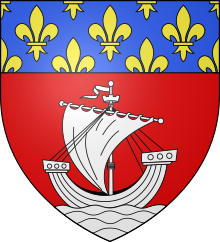List of the bailiffs of Paris
The origins of Paris local government are largely obscure. Originally, the city belonged to the county, which had existed since the late 8th century, and later to the vice-county of Paris , whose owners were vassals of kings from the Carolingian and Capetian dynasties . From the second half of the 11th century, a non-hereditary bailiff (French: Prévôt ), responsible to the king, was entrusted with the administration of the city and the surrounding castle bailiffs in the Vice-County of Paris . From the 12th century a bailiff, elected by the citizens, established himself alongside him in the city. This was chosen from the economically outstanding guild of the Seine river traders, who was therefore called "Vogt of the traders" (French: Prévôt des marchands ).
The responsibilities of both bailiffs do not seem to have been clearly defined, especially with regard to their competencies in the economic life of the city. King Louis IX the saint remedied this in 1261 by placing the royal bailiff in the functions of a baili . These were mainly police and civil judicial competencies. The royal Vogt of Paris roughly corresponded to the office of today's prefect .
In relation to the crown, the bailiff of the merchants exercised a largely autonomous regulatory power and legal authority within the Paris guilds and spoke to the king on behalf of the citizens. However, he was subordinate to the royal bailiff insofar as he could revise his decisions. Since the bailiff of the merchants was the highest office assigned by the citizens, he took on the role of a quasi-mayor for Paris.
List of merchants' bailiffs (Prévôts des marchands) and royal bailiffs (Prévôts) of Paris


Both bailiwicks were dissolved during the French Revolution and the proclamation of the First Republic . The office of the mayor of Paris took the place of the bailiwick of the merchants, and the functions of the royal bailiwick were divided between the Seine prefecture and the Paris police prefecture .


